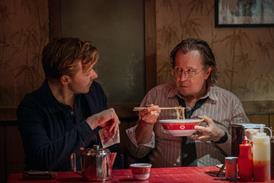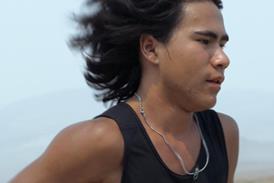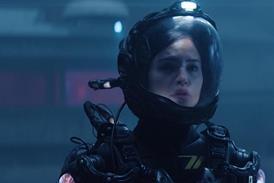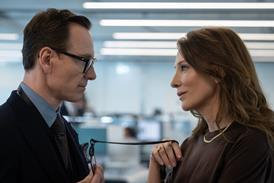Paul Walker is at the wheel in a thriller uniting South African talent and financing with international producers. Screen visits the set.
Paul Walker is not yet bored of crashing cars on-screen, even after his role in four Fast & Furious films. On a sunny August day in Johannesburg in South Africa, he has a triumphant look on his face after he successfully — and safely — crashes a car into a fake storefront window.
Walker is back in the driver’s seat, this time on a more independent scale, with the dramatic thriller Vehicle 19, set in Johannesburg.
“There’s got to be some kind of record here; I don’t know in terms of screen time if anybody has spent more time behind the wheel of a car than I have,” Walker says with a smile. “As a kid I was driving go-carts and I always wanted to race cars. My grandfather was a race-car driver, I inherited his DNA, there’s a driving gene for sure.”
On the Vehicle 19 shoot there was a stunt driver but Walker did most of the driving himself where possible. Audiences will see his driving up close, as the entire film is shot inside the car with Walker. Yes, entirely inside the car.
“I wanted to build that sense of claustrophobia,” says Cape Town-based writer-director Mukunda Michael Dewil, whose first feature was the recent Retribution. “It was always going to be like a thriller that has an edge to it, and was more intimate than a blockbuster.”
Dewil’s script, which made it on to the US 2010 Black List of hot unproduced screenplays, follows a US ex-con who attempts to patch up his relationship with an ex-girlfriend who works in Johannesburg. When he picks up the wrong rental car (an extremely uncool minivan) at the airport, he finds a woman (Naima McLean) in the boot and becomes embroiled in a world of police corruption.
“It’s a redemptive drama dressed up as an action thriller,” explains Dewil.
Walker, who is also an executive producer on the film, was of course tempted by more than the driving. “I like the idea that it was contained, and as familiar as it was, it was different. And I feel like I’ve been that desperate man, trying to make things work.”
One of the film’s producers is Los Angeles-based Peter Safran of The Safran Company, whose credits — fittingly — include another claustrophobic thriller, Buried, about a man trapped alive in a coffin.
“[Walker] has risen to the challenge,” says Safran of the actor, who appears in 95% of the film. “It’s not dissimilar to putting Ryan Reynolds in Buried. People hadn’t seen him do this kind of role.”
Safran is producing with US-born, Johannesburg-based Ryan Haidarian — former head of production and development at South Africa’s National Film and Video Foundation (NFVF) — through Forefront Media. The project has backing from South Africa’s Industrial Development Corporation (IDC) and will also use South Africa’s Department of Trade and Industry’s (DTI) production rebate.
Principal photography wrapped on September 4 and sales company K5 International is showing new footage of the film to buyers at this month’s American Film Market.
“We pre-sold the film really well in Cannes and expect to close out on all remaining territories at AFM once we show a promo,” says K5’s sales chief Carl Clifton.
K5 came on board at script stage for sales and financing (the project’s backers include Kevin Frakes’ PalmStar Media Capital and Los Angeles-based EFish Entertainment). K5’s new head of acquisitions Erica Motley brought the project into the company and early deals include to StudioCanal for the UK and Germany. UTA is handling the US deal, and the film should be delivered in the first quarter of 2012.
“It’s the perfect film for the independent marketplace,” suggests Clifton. “It’s a supercharged, but distinctive, action thriller with a real Hollywood star in the lead.”
Tapping local resources
Vehicle 19 shot completely on location in and around Johannesburg. The film is also doing post-production in the city.
“We’re getting better value for money in Johannesburg,” says co-producer and line producer Gary King of local outfit Picture Tree. “We wouldn’t have had this kind of access somewhere else, [the authorities] are allowing us to do what we need. As a line producer, you want to get as much value on screen [as you can]. Shooting in Johannesburg, the textures of this city are there, we don’t have to create them.”
‘It was always going to be like a thriller that has an edge to it, and was more intimate than a blockbuster’
Mukunda Michael Dewil, director
South Africa’s DTI offers South African films or official co-productions a 35% rebate on the first $730,000 (zar6m) spent in the country and 25% on the remainder of local spend. It has no cap and can be paid in instalments. The government-backed IDC also provides debt and equity financing to projects, as part of its remit to back South African business.
“We want to finance local projects here. It’s amazing how much money and support is available to a South African project through the government — whether the IDC, DTI or the NFVF,” says Ryan Haidarian.
‘Following a car around a city’
Dewil, who used to live on an ashram in India, is not your typical action director. Haidarian describes him as “really Zen”, noting he kept a calm atmosphere on set despite the high-octane stunts and chases and an ambitious 30-day shoot, all filmed in sequence. “He’s very eloquent when he is describing what he wants,” Haidarian points out.
The shoot presented many logistical challenges, not least with the camera in the car. Shooting chronologically and outside a studio meant frequent moves to new locations, often gritty areas known more for carjacking than for car stunts. Dewil admits it is not the easiest proposition to shoot “following a car around a city”, but says he is pleased with the results.
Shooting on 35mm with heavier equipment, it was also a challenge to rig the cars with cameras inside. One solution was to mount cameras on inflatable inner-tubes.
“It allows movement but it’s not shaky. It’s like your body would move in a car,” suggests DoP Miles Goodall of the inner-tube rigs. “I’m glad we didn’t shoot it in a conventional way. We’re going to come up with something noticeably different and take people out of their comfort zones as viewers.”
Goodall, who also shot Retribution with Dewil, is one of many South African heads of department.
“It’s not a compromise using the crews here, they were very well experienced in commercials. They are so fast and talented,” says Safran. “I definitely want to shoot more here.”
Eddie Mbalo, who was the CEO of the NFVF for a decade before stepping down in June, is executive producing Vehicle 19 as his first post-NFVF project at Forefront, the company he set up with Haidarian. He believes this film represents a step forward for the local film scene.
“For me it’s the first South African commercial film that is also wholly owned here,” he notes. “At a certain point we have to start making films that do make money, it’s a business after all.”
Haidarian and Safran plan to re-team on the director’s next script, Kalahari, which Safran dubs, “Open Water but with lions and hyenas in the desert.” Dewil (repped by Charlie Ferraro at UTA) also has plans for a big, Hollywood-level action film.
Mbalo says the smooth Vehicle 19 shoot was a good sign for the future. “It shows the potential of this country if we collaborate with the world.”



















No comments yet